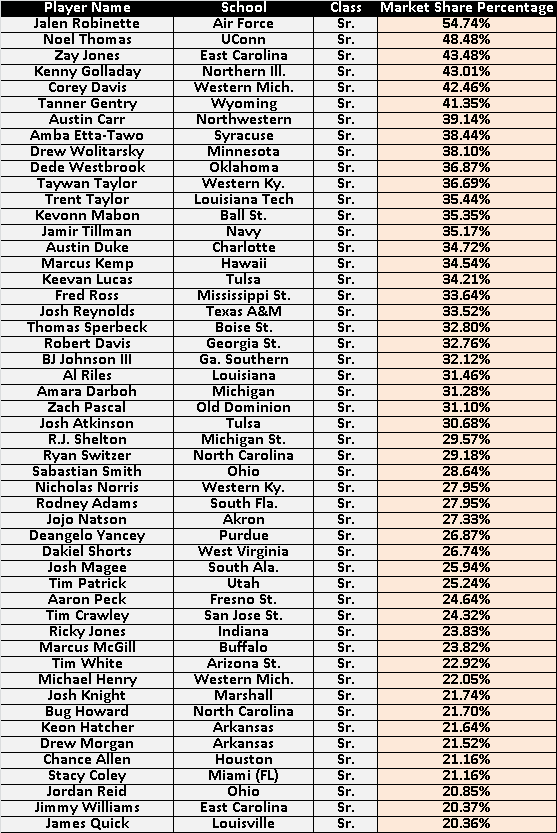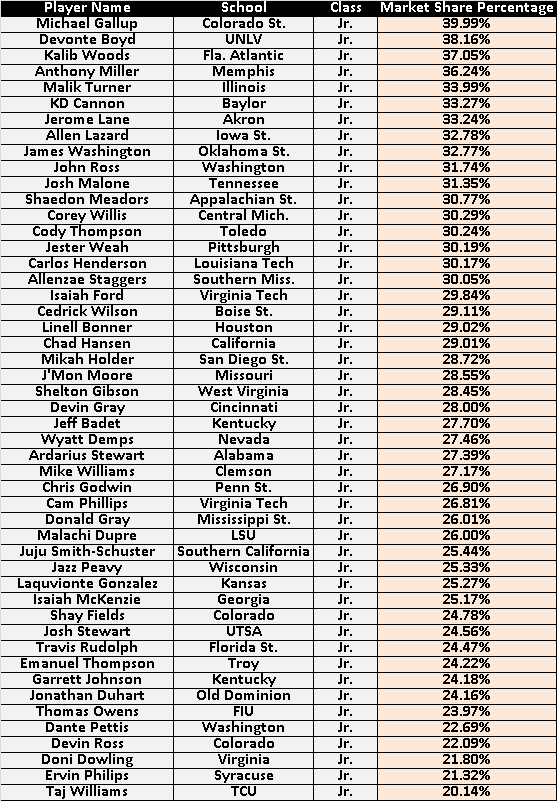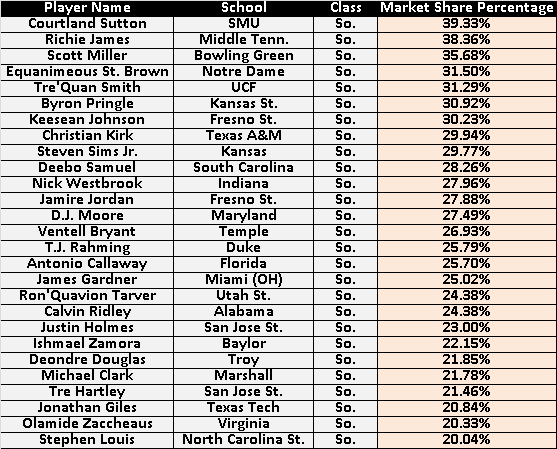2016 College Market Share Report: Wide Receivers
There are many things to take in account when evaluating prospects for the NFL Draft. Athleticsim, production, and how a player looks on tape can all be major factors to player’s stock. Not all players are created equal and some are harder to evaluate than others – the unathletic late round picks who take the league by storm are head scratchers for most evaluators. Leaving stones unturned during prospect evaluation is the best way to miss out on a player, so the best practice would be to utilize all the data at your disposal to make the best decision possible come draft day.
My process is pretty simple. I grind, watch tape and assess as much data as possible, from efficiency metrics to athletic comparisons. Ownership or ‘market share’ of the team’s offensive production, targets, and touches are my favorite data points to analyze because they provide an easy and accurate depiction of how important a player is to their team. Market share data also shines a light on players who are stuck in middling offenses providing little-to-no upside for the player’s offensive production.
Wide receivers are evaluated on their ownership in the passing game. The larger the ownership of the team’s passing production the better. Most high-end wide receiver prospects are able to own a 20 percent market share of higher, and the elite prospects typically are posting around the 35 percent range or higher.
I pulled the nation’s top-200 receivers in receiving yardage, tallied their market share percentages and separated them by class. Separating them this way provides a glimpse of potential breakout ages and how the players stack up against their peers. This data is great for rookie drafts and devy leagues because it gives a quick view of a players production.
I posted an article covering the market share figures for the 2015 season last year, which became a tremendous resource while breaking down prospects for the NFL Draft. Keep in mind, it’s not an absolute when it comes to evaluating players as there are no systems that garner a 100 percent accuracy on wide receiver hit rates. Market share should be utilized in conjunction with many other tools to evaluate players.
[am4show have=’g1;’ guest_error=’sub_message’ user_error=’sub_message’ ]

The senior class will typically carry a higher volume of top end producers because offenses tend to lean on older more experienced players. This class had six players with a 40 percent market share or higher which is rare, considering last year’s senior class only had one wide receiver surpassing the 40 percent bench mark. Due to the level of competition, players from power five schools should carry little extra weight during the evaluation process. Keep in mind, just because a player’s market share is well above average doesn’t make them an elite prospect because there could be other factors negating their potential.
Jalen Robinette, WR Air Force
He managed to catch 35 receptions for 959-yards and six touchdowns with over 100-yards receiving in five games this season. Keep in mind, Air Force only had 1,752 yards passing. We must give credit where credit is due, even with the low stat line, a 54.74 percent market share is incredible, making him a prospect that should be evaluated in more depth before the NFL Draft.
Corey Davis, WR Western Michigan
Davis is one of the top prospects in this year’s draft class and will compete for the consensus 1.01 pick in rookie drafts come spring. His elite 42.46 market share percentage is another reason to have him tagged as one of the top prospects in dynasty. He caught 97 receptions for 1,500-yards and 19 touchdowns with his best game occurring during week ten against Ball State, catching 272-yards and three touchdowns. Davis was one of the top producers in 2015 as well with a 38.48 percent market share which was fourth in the nation amongst junior wide receivers.
Austin Carr, WR Northwestern
He exploded during his senior season by leading the Big Ten with 1,247 yards receiving. Carr is not going to blow up the combine but he will win the hearts of many with his ability to create separation with pristine route running.
Amba Etta-Tawo, WR Syracuse
Etta-Tawo made his senior season count as one of the nation’s top producers with 1,482 and 14 touchdowns. He had seven games with over 100-yards receiving and two games eclipsing the 200-yard mark. His stock is going to be highly dependent how he performs at the combine due to only having one productive season under his belt.
Dede Westbrook, WR Oklahoma
He’s considered one of the top prospects in this year’s draft and his 36.87 percent market share is indicative to his potential at the NFL level. He finished the season leading the Big-12 in receiving with 1,524 yards.
Fred Ross, WR Mississippi State
As one of the most underrated prospects in the nation, Ross caught 917-yards and twelve touchdowns, landing him a 33.64 percent market share within in Mississippi State’s passing offense. He’s a very explosive player with a knack for catching tough contested catches down field.
Josh Reynolds, WR Texas A&M
Reynolds’ 33.52 percent market share is outstanding when you have to take in account that he’s sharing targets with Christian Kirk, Ricky Seals-Jones and Speedy Noil, who are all very talent receivers. Not to mention he was very productive last season by posting a 27.29 percent market share. He blew up in his bowl game against Kansas State, catching 12 receptions for 154-yards and two touchdowns.
Amarah Darboh, WR Michigan
Darboh might possibly be one of the best route runners in the upcoming draft class and he’s rock-solid at converting contested catches in traffic. He won’t blow up the combine but he’s a gamer and is clutch when the chips are down.

KD Cannon, WR Baylor
Baylor’s 3,652 passing yards ranked twenty-second in the nation, making Cannon’s 33.27 percent market share very impressive, because he was able to maintain a large ownership of the team’s production without allowing the extra volume in the passing game to dilute his productivity. His best game of the year came during the Cactus Bowl against Boise State when he caught 14 receptions for 226-yards and two touchdowns.
Allen Lazard, WR Iowa State
Lazard received a lot of a notoriety from draft analysts and enthusiasts going into the 2016 season. He didn’t let his fans down by catching 69 receptions for 1,018-yards and six touchdowns, which equated to a 32.78 percent market share of the team’s passing offense. Unfortunately, we won’t see Lazard in an NFL uniform for at least another year, because he’s not declaring for the NFL draft and will be focusing on building his legacy during his senior season at Iowa State.
James Washington, WR Oklahoma State
He had six games with over 100-yards receiving with his best game coming against Pittsburg during week three when he caught nine receptions for 296-yards and two touchdowns. Washington is going to return to Oklahoma State and will enter the draft in 2018.
John Ross, WR Washington
Ross is considered one of the top receivers in the upcoming draft class due to his ability the stretch the field with his speed. He caught 81 receptions for 1,150-yards and 17 touchdowns with three games with over 100-yards receiving. There’s a very good chance that he will be drafted in the first round in this year’s draft.
Isaiah Ford, WR Virginia Tech
Ford has the speed and the route running ability to be a dangerous player at the NFL level. He led his team in receiving with 1,094-yards and seven touchdowns which led to his 29.84 percent market share of the team’s passing offense. His sophmore season was even more impressive as he finished the year ranked second in the nation with a 39.65 percent market share.
Mike Williams, WR Clemson
Williams is labeled as the top wide receiver in college football by many and has the production to back up that claim with five games with over 100-yards receiving and scoring a touchdown in nine of the 15 games he played in. He does an excellent job at using his size to shield the ball away from the defender while making contested catches and he can pluck balls out of the effortlessly with his strong hands. Williams will be in the mix for the top spot in rookie drafts this spring.
Chris Godwin, WR Penn State
Godwin went off during the Rose Bowl, catching nine receptions for 187-yards and two touchdowns against USC. He had a productive career at Penn State with 2,421-yards and 18 touchdowns during the course of his collegiate career.
Malachi Dupre, WR LSU
Dupre had a down year this season, catching just 41 receptions for just 593-yards and three touchdowns, but with even a less than optimal stat line, he managed to own a 26.00 percent market share of the team’s passing offense. LSU as a team only passed for 2,281 yards, ranking one hundred and sixth in the nation, which means the offense’s inefficiencies could have trickled down to Dupre’s play. He’s a player who will require some extra attention when evaluating in the off-season. He’s a talented prospect who was once deemed one of top receivers in the country and he’s a player that shouldn’t be written off due to his lackluster junior season.
Juju Smith-Schuster, WR USC
He’s one of the most intriquing wide receiver prospects in the nation as he was previously considered one of the top receivers in the county around a year ago but since then his stock has taken a hit. Smith-Schuster is still a talented player who has been very productive during his entire collegiate career.

Courtland Sutton, WR SMU
If you haven’t heard the news, Sutton will be returning to SMU for next season, which is a big hit to this year’s rookie class. Without a doubt he will be the top receiver prospect in the nation next year and he should be on everyone’s watch list. Sutton has the size, production and athleticism to make a major impact come draft day in 2018.
Equanimeous St. Brown, WR Notre Dame
He was a steady producer during his sophomore campaign catching at least five passes in seven games this season. St. Brown finished the season on a high note by having big games against both Virginia Tech and USC.
Christian Kirk, WR Texas A&M
Kirk is the team’s possession receiver, catching 80 or more receptions during both his freshman and sophomore seasons. He has the build of a typical slot receiver in the NFL, at 5-11 and 200-pounds, but his speed and short area quickness sets him apart from the average slot receiver. Kirk also has the skill set to win one on one matchups on the perimeter of the field.
Calvin Ridley, WR Alabama
The heat has left the charcoals since he was dubbed a special prospect last season, but he’s still a player to monitor during the final years of his collegiate career. Expectations might have been set a little to high after his breakout freshman season, but he still managed to catch 72 receptions for 769-yards and seven touchdowns while owning a 24.38 percent market share of the teams passing offense. Patience might be a virtue with Ridley because he’s still a talented prospect who has at least another year of college football to build upon his resume.

Ahmmon Richards, WR Miami
Richards had four games with over 100-yards receiving with his best games coming against Pittsburgh where he caught eight receptions for 144-yards. He’s a head of the curve when it comes to creating separation with his route running.
Bryan Edwards, WR South Carolina
The 6-3 and 210-pound freshman had a very successful season, catching 44 receptions for 590-yards and four touchdowns. Edwards is a player to keep an eye on since he was recruited heavily by a lot of power-five schools, including Clemson, Florida and Georgia.
N’Keal Harry, WR Arizona State
He’s a four-star recruit from Chandler, Arizona who was ranked as the seventh best receiver in his recruiting class. At 6-4 and 210-pounds, he has the initial size you want to see in a young prospect. Harry finished his freshman campaign catching 58 receptions for 659 yards and five touchdowns.
Demetris Robertson, WR California
Robertson was considered the top wide receiver recruit in the nation a year ago due to his blend of athleticism, versatility and ball skills. He caught 50 receptions for 767 yards and seven touchdowns with his best game of the season coming during week 11 against Washington State when he caught six receptions for 141 yards and one touchdown.
All data used in the report was referenced from ncaa.com
[/am4show]
- Dynasty Fantasy Football Rookie Profile: Luke McCaffrey, WR Rice - April 19, 2024
- 2024 Dynasty Fantasy Football Rookie Profile: Will Shipley, RB Clemson - April 6, 2024
- 2024 Dynasty Fantasy Football Rookie Profile: Braelon Allen, RB Wisconsin - March 29, 2024


































































